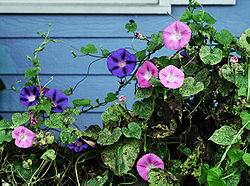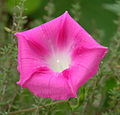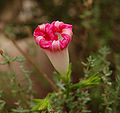Morning glory
From Wikipedia, the free encyclopedia
Morning glory is a common name for over 1,000 species of flowering plants in the family Convolvulaceae, whose current taxonomy and systematics is in flux. Morning glory species belong to many genera, some of which being:
- Calystegia
- Convolvulus
- Ipomoea
- Merremia
- Rivea
- Astripomoea
- Operculina
- Stictocardia
- Argyreia
- Lepistemon
Contents |
[edit] Habit
The flower typically lasts for a single morning and dies in the afternoon. New flowers bloom each day. The flowers usually start to fade a couple of hours before the petals start showing visible curling. They prefer full sun throughout the day and mesic soils. Some morning glories, such as Ipomoea muricata, are night blooming flowers.
In some places such as Australian bushland, morning glories develop thick roots and tend to grow in dense thickets. They can quickly spread by way of long creeping stems. By crowding out, blanketing and smothering other plants, morning glory has turned into a serious invasive weed problem.
[edit] Cultivation
In cultivation, most are treated as perennial plants in tropical areas and as annual plants in colder climates, but some species tolerate winter cold. Some moonflowers, which flower at night, are also in the morning glory family.
Because of their fast growth, twining habit, attractive flowers, and tolerance for poor, dry soils, some morning glories are excellent vines for creating summer shade on building walls when trellised, thus keeping the building cooler and reducing heating and cooling costs.
Popular varieties in contemporary western cultivation include "Sunspots", "Heavenly Blue", the moonflower, the cypress vine, and the cardinal climber. The cypress vine is a hybrid, with the cardinal climber as one parent.
[edit] History
Morning glory was first known in China for its medicinal uses, due to the laxative properties of its seeds. It was introduced to the Japanese in the 9th century, and they were first to cultivate it as an ornament. A rare brownish-coloured variant known as Danjuro is very popular. During the Edo Period, it became a very popular ornamental flower. Aztec priests in Mexico were also known to use the plant's hallucinogenic properties. (see Rivea corymbosa).
Ancient Mesoamerican civilizations used the morning glory species Ipomoea alba to convert the latex from the Castilla elastica tree and also the guayule plant to produce bouncing rubber balls. The sulfur in the morning glory's juice served to vulcanize the rubber, a process pre-dating Charles Goodyear's discovery by at least 3,000 years.[1]
[edit] Culinary uses
Ipomoea aquatica, known as water spinach, water morning-glory, water convolvulus, Ong-Choy, Kang-kung, or swamp cabbage, is popularly used as a green vegetable especially in East and Southeast Asian cuisines. It is a Federal Noxious Weed, however, and technically it is illegal to grow, import, possess, or sell. See: USDA weed factsheet. As of 2005, the state of Texas has acknowledged that water spinach is a highly prized vegetable in many cultures and has allowed water spinach to be grown for personal consumption. This is in part because water spinach is known to have been grown in Texas for more than fifteen years and has not yet escaped cultivation.[2] The fact that it goes by so many names means that it easily slips through import inspections, and it is often available in Asian or specialty produce markets.
[edit] Ethnobotany
The seeds of many species of morning glory contain ergot alkaloids such as the hallucinogenic ergonovine and ergine (LSA). Seeds of I. tricolor and I. corymbosa (syn. R. corymbosa) are used as psychedelics. The seeds can produce similar effect to LSD when taken in the hundreds. Though the chemical LSA is illegal to possess in pure form, the seeds are found in many gardening stores, however, the seeds from gardening stores MAY be coated in some form of pesticide in order to prevent ingestion or methylmercury to retard spoilage.[3] The seeds are especially dangerous if you have a history of liver disorders. During pregnancy they can cause uterine contraction that can lead to miscarriage. The seeds are vasoconstrictive, so should be left alone if you are elderly or have a history or family history of cardiovascular disease (heart attack, blood clot or stroke).[4][5][6] The Datura stramonium is also hallucinogenic, and is poisonous.
[edit] Gallery
[edit] References
- ^ "Rubber processed in ancient Mesoamerica, MIT researchers find - MIT News Office". http://web.mit.edu/newsoffice/1999/rubber-0714.html.
- ^ http://texinfo.library.unt.edu/Texasregister/html/2005/jun-24/adopted/31.NATURAL%20RESOURCES%20AND%20CONSERVATION.html
- ^ Johnson, Timothy (1999). CRC Ethnobotany Desk Reference. CRC Press. pp. 431. ISBN 084931187X.
- ^ "A '60s Buzz Recycled - washingtonpost.com". http://www.washingtonpost.com/wp-dyn/content/article/2006/05/02/AR2006050201413.html.
- ^ "The Washington Post takes another bad drug trip. - By Jack Shafer - Slate Magazine". http://www.slate.com/id/2141138/.
- ^ "DrugScope". http://www.drugscope.org.uk/druginfo/drugsearch/ds_results.asp?file=\wip\11\1\1\morning_glory.htm.
[edit] External links
 Media related to Morning glory at Wikimedia Commons
Media related to Morning glory at Wikimedia Commons The Wiktionary definition of morning glory
The Wiktionary definition of morning glory- Erowid Morning Glory Vault - section from Erowid's vast reference site.
[edit] Further reading
- Everitt, J.H.; Lonard, R.L., Little, C.R. (2007). Weeds in South Texas and Northern Mexico. Lubbock: Texas Tech University Press. ISBN 0-89672-614-2














